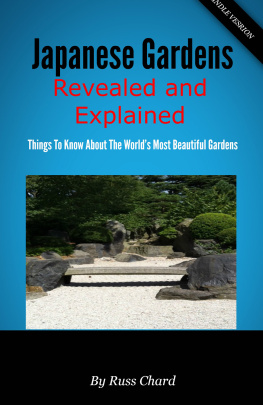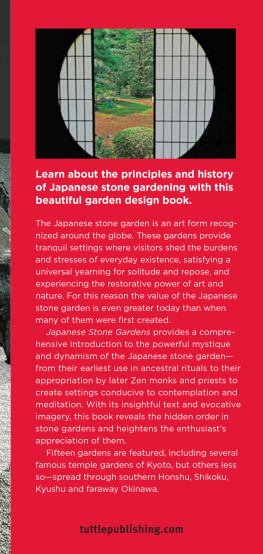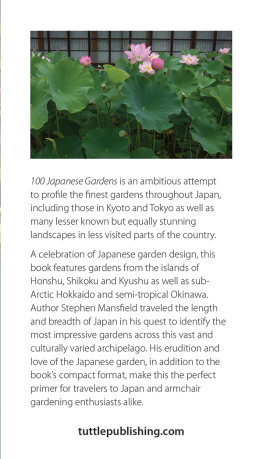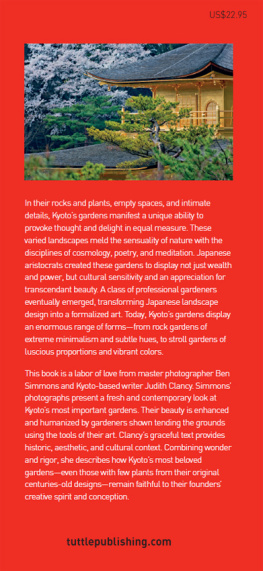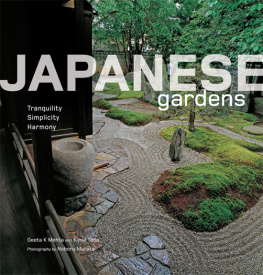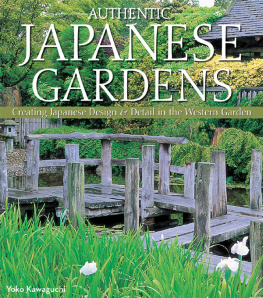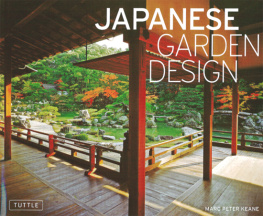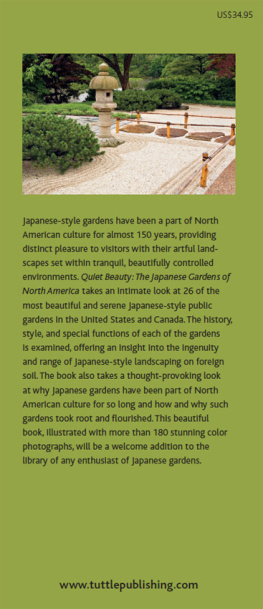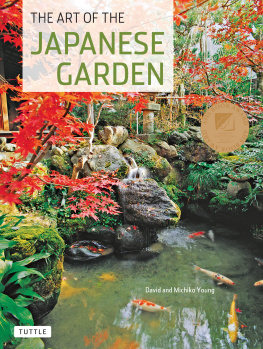Acknowledgments
I T IS ALWAYS a pleasant task to thank those who have helped you. In this instance it can truly be said that it was the encouragement and generous assistance of many Japanese well-wishers that brought this book into being. Though it would be impossible to list them all, I shall never forget the many friendly, open doors of private homes and temples where I was always so cordially received. No matter how busy they were, housewives, homeowners, and temple priests were proud and happy to invite me inside, to show their houses and gardens, and to talk to me over a hospitable, warming cup of tea.
There are also those to whom I must especially express my gratitude. First, to Tansai Sano, artist, garden designer, and builder. He is a humble man of taste and sensitivity who, while deeply loving the rich heritage of his country's culture, still does not hesitate to try, with bright, creative originality, new forms of artistic expression in a garden. He is my teacher and my friend. With enthusiasm he accepted me as his pupil. With gentle humor and patience he-listened to my questions. And he taught me not only principles of garden design and construction, but also to see gardens as a joyful part of the human adventure.
I am also grateful to the Landscape Architecture Department of the Faculty of Agriculture of Kyoto University for the use of its well-stocked library. I am deeply indebted to Professor Eitaro Sekiguchi and his staff, and especially to Makoto Nakamura, who helped me with his friendly criticism and advice.
I am thankful also to the Faculty of Architecture of Tokyo University of Fine Arts, where I was registered; to Professor Junzo Yoshimura, who smoothed the way; to Professor Isoya Yoshida; and to Gakuji Yamamoto, for his encouraging and helpful letters.
As indicated below, for many of the photographs in this book I am obliged to Seiichi Sano, who is following in his father's distinguished tradition of garden building, and to Yoshio Takahashi, who spent almost two years photographing gardens all over Japan for the publishing house of Kodansha.
The staff of the City of Kyoto's Bureau of Tourist Industry were most helpful and cooperative in securing for me introductions and passes to many of the gardens. And, above all, with fondness and gratitude my appreciation goes to my friend Eiko Yuasa, of that office, who typed the manuscript for me and in countless hospitable, generous ways helped me during my stay in Japan. I thank my friend Kiyoshi Makino, the Tokyo architect, who allowed me to use the pictures of the Sassakawa, designed by him.
To Hiroshi Uemura, garden designer and builder in Kanazawa, who gave so generously of his time and whose name unlocked many a garden gate, I feel grateful obligation.
My thanks to Tadashi Kubo, of the Agricultural Faculty of Osaka Prefectural University, who sent me his compilation of the Sakutei-ku For their help with many of the drawings I am obliged to Shiotaro Shizuma and Shigeo Fujita.
I owe gratitude to the Japanese government, which awarded me, through its Ministry of Education, a grant to study garden design and construction in Japan.
And to the Japan Society in New York, which helped me to get started on this study project, I am most grateful.
The gardens of Messrs. Tomoda, Mizoguchi, Kaba, Watanabe, Tamura, and Ishida and of the Narita Fudo and the Kicho, illustrated in pages which follow, were designed and built by Tansai Sano. The garden of Mr. Akaza was designed and built by Hiroshi Uemura.
The sources of the photographs used in the book are as follows, all those not otherwise indicated having been taken by the. author:
By Seiichi Sano: Plates .
By Yoshio Takahashi, and used by courtesy of Kodansha, Tokyo: Color Plates .
Courtesy of the Bureau of Tourist Industry, Kyoto: Plates .
Courtesy of Kiyoshi Makino: Plates .
DAVID H. ENGEL
Japanese Gardens for Today

Bibliography
On Japanese Gardens
Amanuma, Shinichi; Shigemori, Mirei; and Nakano, Sokei (eds.): Teien: Kyoto Bijutsu Taikan (Gardens: Kyoto Art Survey). Tokyo, 1933.
Kitao, Harumichi: Satei (Teahouse Gardens). Shokokusha, Tokyo, 1954.
Kubo, Tadashi: "An Oldest Note of Secrets on Japanese
Gardens: A Compilation of the 'Sakutei-ki'." Bulletin of Osaka Prefectural University, Series B, Vol. 6, 1956.
Kuck, Loraine E.: The Art of Japanese Gardens. John Day, New York, 1940.
: One Hundred Kyoto Gardens. Thompson (Bunkado), Kobe, 1936.
Newsom, Samuel: A Thousand Years of Japanese Gardens. Tokyo News Service, Tokyo, 1953.
Nishimura, Tei: Niiva to Chashitsu (Gardens and Tea-houses). Kodansha, Tokyo, 1957.
Rito, Akisato: Shinsen Teizo Den (Report on a New Selection of Gardens). 1828.
: Tsukiyama Teizo Den (Report on the Building of Artificial-Hill Gardens). 1828.
Saito, Katsuo: Niwa Tsukuri (Garden Making). Gihodo, Tokyo, 1955.
: Sho Teien (The Small Garden). Kawade Shobo, Tokyo, 1954.
Shigemori, Kanto: Nihon no Teien Geijutsu (Artistic Gardens of Japan), 3 v. Riko Tosho, Tokyo, 1957.
Shigemori, Mirei: Kinki Meien no Kansho (An Appreciation of Noted Gardens in the Kinki Region). Kyoto Inshokan, Kyoto, 1946.
Takakuwa, Gisei: Gardens of Japan. Suiko Shoin, Kyoto, 1958.
Tamura, Tsuyoshi: Art of the Landscape Garden in Japan. Trans, by Sumie Mishima, Kokusai Bunka Shinkokai, Tokyo, 1947.
: Jar din Japonais: Ses Origines et Caracteres, Dessins et Plans. Kokusai Bunka Shinkokai, Tokyo, 1939.
Tatsui, Matsunosuke: Japanese Gardens. Japan Travel Bureau, Tokyo, 1956.
Tsumura, Hideo: Nippon Teien Shu (A Collection of Japanese Gardens). Kodani Shobo, Osaka, 1955.
Yoshinaga, Yoshinobu: Nihon no Teien (Japanese Traditional Gardens). Shokokusha, Tokyo, 1958.
On Related Japanese Subjects
Horiguchi, Sutemi: Katsura Rikyu (Katsura Imperial Villa). Mainichi, Tokyo, 1957.
Murasaki Shikibu, Lady: The Tale of Genji: A Novel in Six Parts. Trans, by Arthur Waley. Allen & Unwin, London, 1935.
Niwa, Teizo; Katsura Rikyu no Tobi-ishi (Steppingstones of the Katsura Imperial Villa). Shokokusha, Tokyo, 1955.
Okakura, Kakuzo (Tenshin): The Book of Tea. Tuttle, Tokyo & Rutland, 1956.
Taniguchi, Yoshiro: Shugaku-in Rikyu (Shugaku-in Imperial Villa). Mainichi, Tokyo, 1956.
Usami, Kanji: Sukiya Gonomi (Sukiya-Style Garden Structures). Yachio Shoin, Tokyo, 1955.
Yoshimura, Yuji, and Halford, Giovanna M.: The Japanese Art of Miniature Trees and Landscapes: Their Creation, Care, and Enjoyment. Tuttle, Tokyo & Rutland, 1957.
On Landscape Design
Church, Thomas D.: Gardens Are for People. Reinhold, New York, 1955.
Eckbo, Garrett: Landscape for Living. Architectural Record Book, Dodge, New York, 1950.
Hubbard, Henry Vincent, and Kimball, Theodora: An Introduction to the Study of Landscape Design. Macmillan, New York, 1924.
Rose, James: Creative Gardens. Reinhold, New York, 1958.
Tunnard, Christopher: Gardens in the Modern Landscape.
Architectural Press, London, and Scribner's, New York; 1948.
On Plant Materials
Bailey, L. H., and the staff of the Bailey Hortorium, Cornell University: Manual of Cultivated Plants Most Commonly Grown in the Continental United States and Canada. Macmillan, New York, 1939.
Kelsey, Harlan P., and Dayton, William A. (Editorial Board of American Joint Committee on Horticultural Nomenclature) : Standardized Plant Names. J, Horace McFarland Co.; Harrisburg, Pa.; 1942.
Levison, J. J.: The Home Book of Trees and Shrubs. Knopf, New York, 1949.
Wyman, Donald: Ground Cover Plants. Macmillan, New York, 1950.



